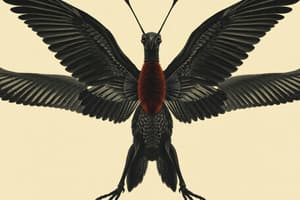Podcast
Questions and Answers
Match the following animals with their primary mode of transportation:
Match the following animals with their primary mode of transportation:
Ants = Land Birds = Air Fish = Sea Elephants = Land
Match the following modes of transportation with their descriptions:
Match the following modes of transportation with their descriptions:
Flying = Mode used by birds and bats to cover great distances Swimming = Mode used by aquatic animals to navigate underwater environments Walking = Mode of terrestrial locomotion for many land animals Gliding = Mode of transportation involving controlled descent from heights
Match the following animals with their habitat preference:
Match the following animals with their habitat preference:
Swift fox = Deserts Birds = Varied habitats Fish = Water bodies Ants = Nests
Match the following sounds with the animals that produce them:
Match the following sounds with the animals that produce them:
Match the following animals with their unique way of interacting with plants:
Match the following animals with their unique way of interacting with plants:
Match the following animals with their primary mode of transportation:
Match the following animals with their primary mode of transportation:
Match the following animals with their habitats:
Match the following animals with their habitats:
Match the following animals with their primary caregiver roles:
Match the following animals with their primary caregiver roles:
Match the following animal sounds with their communication purposes:
Match the following animal sounds with their communication purposes:
Match the following animal-plant relationships with their roles:
Match the following animal-plant relationships with their roles:
Study Notes
Animals and Their Relationships with Plants, Habitats, Sounds, and Transportation
Animals play significant roles in ecosystems worldwide, and their interactions with plants, habitats, sounds, and modes of transportation are essential to their survival and overall health. In this article, we will explore these relationships through various examples and perspectives.
Modes of Transportation
Transportation is crucial for the movement of organisms across vast distances, enabling them to adapt to different environments and interact with diverse species. There are three main types of transportation: land, air, and sea. Each mode has its unique characteristics and challenges.
-
Land
Some animals have evolved specialized means of locomotion adapted to terrestrial environments. These include walking, crawling, hopping, slithering, galloping, flying, burrowing, swimming, gliding, or climbing. Examples include ants carrying food back to their nest, the swift fox moving across deserts, and elephants knocking trees down to create open space.
-
Air
Birds and bats rely on flight to traverse large expanses; they can cover great distances while searching for resources, such as food. This allows them to exploit seasonal variations in habitat availability, ensuring their survival. Other birds and insects migrate to breeding grounds.
-
Sea
Aquatic animals have also developed strategies to navigate underwater environments. For example, fish use fins for propulsion and maneuverability, while marine mammals like whales and dolphins display impressive endurance and speed through coordinated limb movements. Some aquatic animals, like sea turtles, travel immense distances throughout their lives.
Animal Habitats
Habitat selection plays a vital role in determining an animal's distribution, abundance, and behavior patterns. Different species rely on specific microhabitats within a larger ecosystem. These may vary from desert shelters, riverine or wetland zones, montane forests, and mountainous regions. Understanding habitat suitability helps us manage wildlife populations more effectively.
For instance, some snakes live near water sources, whereas others seek out dry, sandy soil for heat regulation. The arctic fox's habitat includes both coastal cliffs and open ground, where it can hunt small mammals. Similar preferences apply to other species as well.
Care of Pets
Pets play integral roles in human society, offering companionship, protection, and even therapeutic benefits. Properly caring for pets involves providing adequate nutrition, exercise, socialization, training, and healthcare. Emotional support animals (ESAs) assist people with mental, emotional, or physical disabilities by providing comfort and reducing stress.
Animal Sounds
Sound production is another aspect of animal life that connects them to their surroundings and communicates important information about their health, reproduction, aggression, and navigation abilities. For example, the song of a male bird can help attract females during breeding season, while growling noises from predators like bears can alert potential prey of danger.
Interdependency between Plants and Animals
The relationship between plants and animals is symbiotic, with each providing essential services that benefit the other. This interdependence ensures ecosystem stability and influences species distribution patterns.
-
Herbivores
Herbivores, such as rabbits, deer, and elephants, consume plants for food and energy, but they also play essential roles in shaping ecosystems through their foraging activities. They help control plant populations, create habitats by removing undergrowth, and spread seeds for new growth.
-
Pollinators
Bees, birds, butterflies, and other insects are crucial pollinators that enable the reproduction of plants via cross-pollination. This helps preserve genetic diversity within plant species and maintains their health.
In conclusion, animals have complex relationships with their environments, which include modes of transportation, habitats, sounds, and interdependence with plants. Understanding these interactions is key to managing wildlife populations effectively and fostering coexistence between humans and nature.
Studying That Suits You
Use AI to generate personalized quizzes and flashcards to suit your learning preferences.
Description
Explore the intricate connections between animals and their environments, including interactions with plants, habitats, sounds, and modes of transportation. Learn about the significance of habitat selection, animal sounds, interdependency with plants, and caring for pets.




